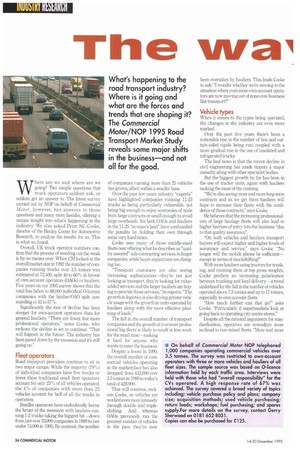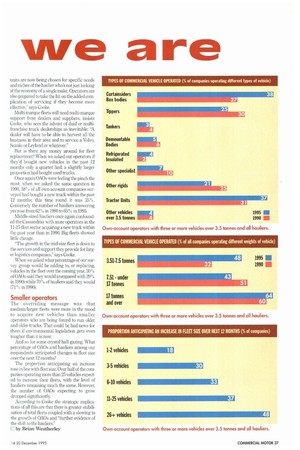The vval
Page 38

Page 39

If you've noticed an error in this article please click here to report it so we can fix it.
we are
What's happening to the road transport industry? Where is it going and what are the forces and trends that are shaping it? The Commercial Motor/NOP 1995 Road Transport Market Study reveals some major shifts in the business—and not all for the good.
Where are we and where are we going? Two simple questions that truck operators seldom ask, or seldom get an answer to. The latest survey carried out by NOP on behalf of Commercial Motor, however, has answers to those questions and many more besides, offering a unique insight into what's happening in the industry. We also asked Peter NC Cooke, director of the Henley Centre for Automotive Research, to analyse the results for us. This is what we found.
Overall, UK truck operator numbers confirm that the process of weeding out the weak is by no means over. When CM looked at the overall market size in 1992 the number of companies running trucks over 3.5 tonnes was estimated at 72,400, split 40 to 60% in favour of own-account operators (0A0s) vs hauliers. Five years on our 1995 survey shows that the total has fallen to 68,000 individual 0-licence companies with the haulier/OAO split now standing at 43 to 57%.
Significantly the rate of decline has been steeper for own-account operators than for general hauliers. "There are fewer, but more professional operators," notes Cooke, who reckons the decline is set to continue: "That will happen in the future. The industry has been pared down by the recession and it's still going on."
Fleet operators
Road transport providers continue to sit in two major camps. While the majority (79%) of individual companies have five trucks or fewer these traditional small fleet operators account for only 23% of all vehicles operated; the 4% of companies with more than 25 vehicles account for half of all the trucks in operation.
Smaller operators have undoubtedly borne the brunt of the recession with hauliers running 1-2 trucks taking the biggest hit—down from just over 23,000 companies in 1988 to just under 15,000 in 1995. By contrast, the number of companies running more than 25 vehicles has grown, albeit within a smaller base.
Over the past few years industry "experts" have highlighted companies running 11-25 trucks as being particularly vulnerable, not being big enough to enjoy economies of scale from large contracts or small enough to avoid large overheads. Yet both 0A0s and hauliers in the 11-25 "no-man's land" have confounded the pundits by holding their own through some very hard times.
Cooke sees many of those middle-sized fleets now offering what he describes as "quality assured" sub-contracting services to larger companies, while buyer aspirations are changing too.
"Transport customers are also seeing increasing sophistication—they're not just looking at transport, they're looking for valueadded services and the larger hauliers are hoping to provide those services," he reports. 'The growth in logistics is also driving greater vehicle usage with the growth in units operated by hauliers along with the more effective planning of loads."
The fall in the overall number of transport companies and the growth of evermore professional big fleets is likely to result in less work for the small man—making it hard for anyone who wants to enter the business Despite a boom in 1990, the overall number of commercial vehicles operating in the marketplace has also dropped: from 432,600 over 3.5 tonnes in 1988 to today's total of 428,900.
That will continue, reckons Cooke, as vehicles are worked even more intensely through double and tripleshifting. And whereas 0A0s previously ran the greatest number of vehicles in the parc they've now been overtaken by hauliers. This leads Cooke to ask: "I wonder whether we're moving to the situation where even more own-account operators are now moving out of none-core business like transport?"
Vehicle types
When it comes to the types being operated, the changes in the industry are even more marked, Over the past five years there's been a noticeable rise in the number of box and curtain-sided rigids being run, coupled with a more gradual rise in the use of insulated and refrigerated trucks.
The bad news is that the recent decline in civil engineering has made tippers a major casualty along with other specialist bodies.
But the biggest growth by far has been in the use of tractor units, again with hauliers making the most of the running.
"We're also seeing more and more long-term contracts and as we get them hauliers will hope to increase their fleets with the confidence of those contracts," says Cooke.
He believes that the increasing professionalism of large haulage fleets will also lead to higher barriers of entry into the business "due to that quality assurance".
"On both vehicles and hauliers transport buyers will expect higher and higher levels of assurance and service," says Cooke. "No longer will the mobile phone be sufficient— except in terms of muckshifting!"
With more hauliers using tractors for trunking, and running them at top gross weights, Cooke predicts an increasing polarisation between trunking and local delivery—a trend underlined by the fall in the number of vehicles operated above 7.5 tonnes and up to 17 tonnes, especially in own-account fleets.
"How much further can that go?" asks Cooke, "Particularly if supermarkets look at going back to operating city centre stores" Despite all the rational arguments for standardisation, operators are nowadays more inclined to run mixed fleets. "More and more units are now being chosen for specific needs and niches of the haulier who's not just looking at the economy of a single make. Operators are also prepared to take the hit on the added complication of servicing if they become more effective," says Cooke.
Multi-marque fleets will need multi-marque support from dealers and suppliers, insists Cooke, who sees the advent of dual or multifranchise truck dealerships as inevitable: "A dealer will have to be able to harvest all the business in their area and to service a Volvo, Scania or Leyland or whatever."
But is there any money around for fleet replacement? When we asked our operators if they'd bought new vehicles in the past 12 months only a quarter had: a slightly larger proportion had bought used trucks.
Once again ()MX were feeling the pinch the most: when we asked the same question in 1990,38% of all own-account companies surveyed had bought a new truck within the past 12 months; this time round it was 35%. Conversely the number of hauliers answering yes rose from 62% in 1990 to 65?-. in 1995.
Middle-sized hauliers once again confounded the Cassandras with more operators in the 11-25 fleet sector acquiring a new truck within the past year than in 1990. Big fleets showed little change.
"The growth in the mid-size fleet is down to the services and support they provide for larger logistics companies," says Cooke.
When we asked what percentage of our survey group would be adding to, or replacing, vehicles in the fleet over the coming year, 30% of 0A0s said they would (compared with 29% in 1990) while 70% of hauliers said they would (71% in 1990).
Smaller operators
The overriding message was that medium/larger fleets were more in the mood to acquire new vehicles than smaller operators who are being forced to run older and older trucks. That could be bad news for them if environmental legislation gets even tougher than it is now And so for some crystal ball gazing. What percentage of 0A0s and hauliers among our respondents anticipated changes in fleet size over the next 12 months?
The proportion anticipating an increase rose in line with fleet size. Over half of the companies operating more than 25 vehicles expected to increase their fleets, with the level of hauliers remaining much the same. However, the number of 0A0s expecting to grow dropped significantly.
According to Cooke the strategic implications of all this are that there is greater stabilisation of total fleets coupled with a slowing in the growth of 0A0s and "further evidence of the shift to the hauliers."
by Brian Weatherley












































































































